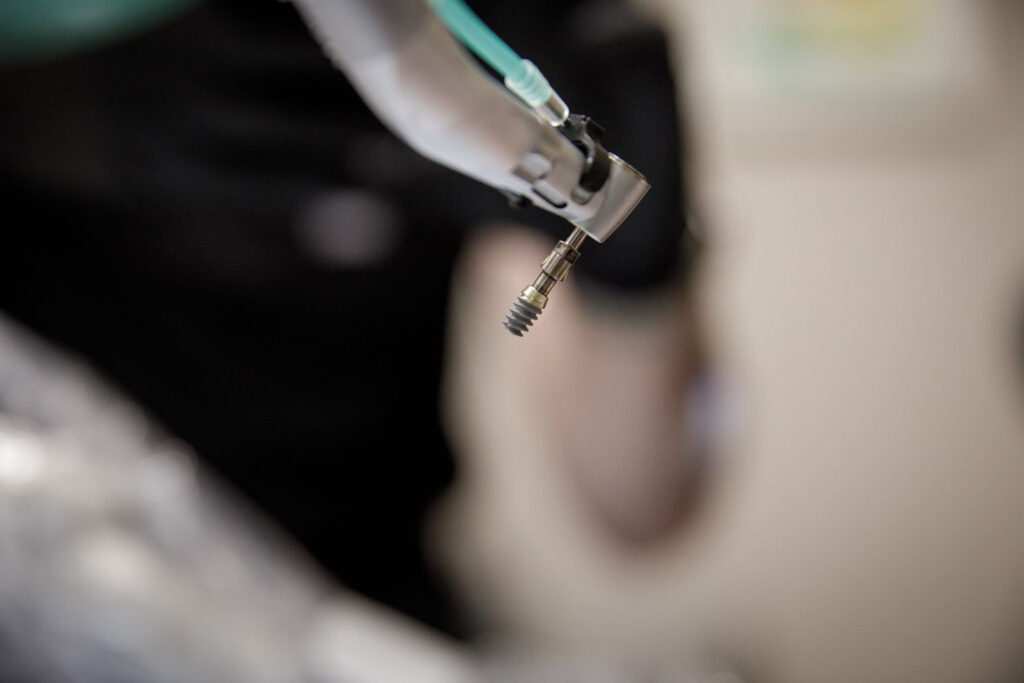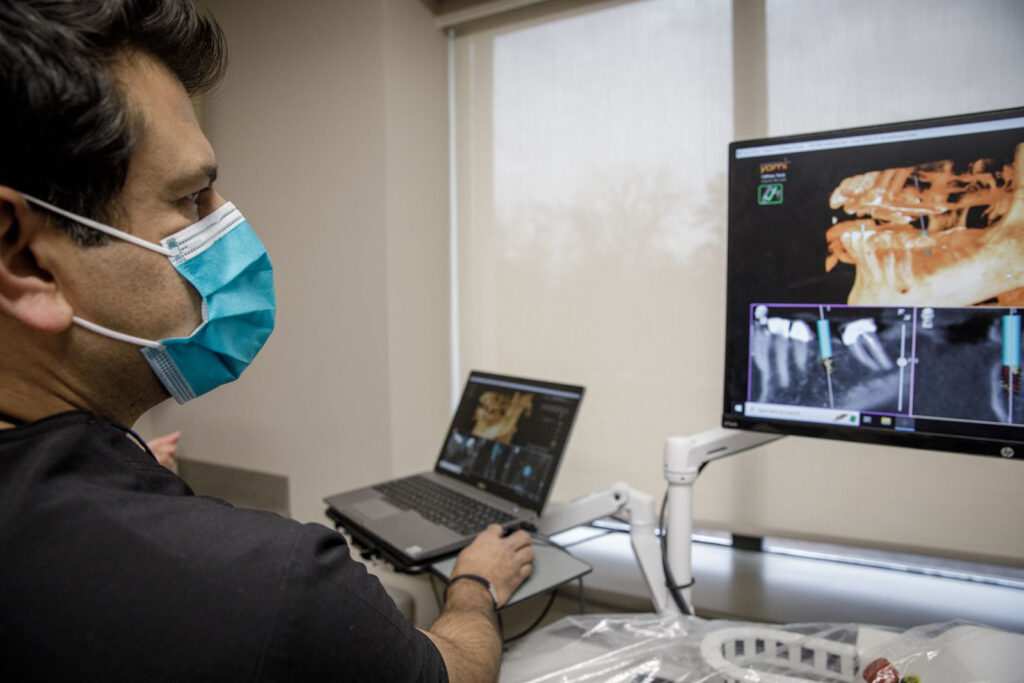Dr. Ryaz Ansari, a West Hartford, Connecticut, oral surgeon, knows how important it is to have teeth that are aligned and pain-free.
That’s why Ansari, whose practice is called Jaw Fixers, has the assistance of a robot to guide him as he drills into the jawbone to create the implant.
“With placing implants into the jaw, you need to do it with great precision and accuracy,” Ansari said. “And to be able to do it precisely because you have adjacent vital structures,” including nearby teeth and their roots.

The position of the implant is vital as well. “You have to place this implant at the right angle, at the right depth, in the right buccal-lingual position, which means between the outside and the inside surfaces,” he said.
That way, the patient’s dentist can make a crown, “which is replicating the original anatomy so that it can last for a long time,” Ansari said.
Enter the Yomi dental robot, the only system approved by the Food and Drug Administration, which guides Ansari as he is drilling to make the operation as accurate as possible.
The result is surgery that is shorter and less invasive to the jaw, Ansari said. However, he said, “it’s not the robot that’s doing the surgery. The robot is assisting me to do my surgery more precisely and accurately.”
Fully automated robotic surgery may come, though. “I can see it happening in four to five years, but that’s not what we’re doing today,” he said.

“The crux of it is that it allows us to place it very precisely,” Ansari said. “And then in the jaw you also have things like nerves. There’s a lot of things crammed up in a very tight spot. And so that’s where robotics helps.”
Ansari said he helped develop the Yomi, which is based on similar robots used for knee replacements. He uses it for 80% of his implants. Some cases require a visual inspection after being drilled, which makes the robot impractical, he said. An example might be if there’s a bone deficiency that requires grafting.
Made by Neocis, Yomi has been approved since 2017 for single teeth and since 2020 for full arches. It’s the only one of its kind. Ansari said he’s performed about 1,000 implants using the machine, which is one of only two in Connecticut, both in West Hartford.

“We’ve been doing implants for 30 years,” Ansari said. “And up until now it’s been free-handed. So you’re spending a lot of time looking, adjusting in the mouth … so it takes longer to do the surgery. You spend more time in the patient’s mouth, trying to figure things out. Now what the robotics allows us to do is that we’re able to do the complete surgery outside the mouth.”
The robot uses a 3D scan of the patient’s mouth with the exact angles and depths needed to drill into the bone to screw in the implant. Ansari performs the surgery first on the computer, which creates a plan that the robot then follows during the actual surgery.
“So that cuts time, so the patient is here for about an hour and a half in the office,” he said. “But the surgical time is only about 10 minutes, the actual time that I’m in the mouth, numbing the patient up and placing this implant.”

Ansari knows ahead of time exactly what he’ll be doing because he’s already done it on the computer, he said. And the benefits to the patient are large as well.
“If it’s more conservative, less invasive, then of course the post-operative course is favorable as well,” he said. “So less swelling, less discomfort, all those things are advantageous as well.”
Another arm clips onto the opposite side of the jaw and can send a signal to the drilling arm within milliseconds if the patient moves, Ansari said.
“Another cool thing about that robot is that once you have planned it, and it locks into the patient’s head, now the patient can move,” he said. “They don’t have to hold still or anything and the robot in milliseconds changes the plan so that it’s able to adjust to the new position of the head.”
During the surgery, once Ansari comes close to the implant site, he will say “guided.”
“My assistant then puts the robot into guided mode, and then it locks into that site,” he said. “Once it’s locked in, it determines the angle and I can only push the drill up and down. I can’t move it from side to side. But it’s delivered the plan exactly as I’ve planned it out on the computer, and it has a hard stop to it.”
In other words, he can’t drill farther into the jaw than the plan has determined, so he can’t drill into the large nerve that runs beneath the lower teeth or unintentionally break into the sinus cavity above the upper jaw.
“You have two teeth on either side, and it’s a very tight spot,” Ansari said. “And were talking about millimeters here, tenths of a millimeter.” The robot centers the implant, how deep the drill will go and the angle of the drill, he said.
The robot also can cut bone since it’s been approved to replace an arch, when all the teeth on top or bottom are removed.
“The robot also allows us to cut the bone in a certain manner that’s predetermined with precision,” Ansari said. “So it does that as well. And that’s the future implication of the robot is to be able to make bony cuts for other major surgery in the jaw.”
Ansari said robotic surgery doesn’t cost the patient more than manual surgery, because insurance covers the procedure, not the device used. “This technology is just added value, basically,” he said. The robot has replaced the need to take an impression and send a plaster model to a lab, which would send back an acrylic guide that would fit over the teeth.
The problem was that the guide was static, while the robot is dynamic, Ansari said.
“If I want to change the position a little bit or I find the bone is too soft or I want to move it this way or that way or higher or lower, I can change that plan on the fly,” he said.
“It went very well, much better than I expected after all I had heard about implants,” said Ferne Hoffman of Bloomfield, who recently had an implant in a left molar.
“He had a drill … and the robot told him exactly where to put the implant and the robot directs it more accurately than if you do not have the robot,” she said.
Hoffman said she received an injection for pain and just felt like there had been something in her mouth. “You have a lot in your mouth, so when they take it out you feel it,” she said.
“I can’t say enough about the staff. They just are so lovely and explain everything before they do it,” she said.
Compared to friends who have had implants, “mine seemed to go really well,” she said.
Leon Carter of Hartford, who has had four teeth done with the robot, said it looks like “something out of Star Wars.”
Carter said he was most concerned about pain. “There was a little pain but it’s nothing in comparison to when you get a wisdom tooth extracted,” he said.
“It goes back to, are you comfortable in talking to your doctor, and your doctor explains what’s going to happen,” Carter said. “And so at a particular point I just said, … I’m glad I went through it. Because now that I have the teeth in the bottom you don’t even know that they’re not yours.”
___
© 2022 Hartford Courant
Distributed by Tribune Content Agency, LLC.



